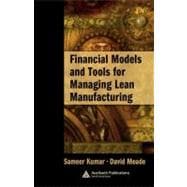
Note: Supplemental materials are not guaranteed with Rental or Used book purchases.
Purchase Benefits
What is included with this book?
| Key Features of This Book | xi | ||||
| Preface | xv | ||||
| Acknowledgments | xvii | ||||
| About the Authors | xix | ||||
| Contribution of This Book | xxi | ||||
| 1 Introduction | 1 | (10) | |||
|
2 | (3) | |||
|
5 | (1) | |||
|
6 | (1) | |||
|
7 | (1) | |||
|
8 | (3) | |||
| 2 Impact of Management Accounting Methods on Lean Implementation | 11 | (16) | |||
|
11 | (3) | |||
|
14 | (2) | |||
|
16 | (2) | |||
|
18 | (2) | |||
|
20 | (3) | |||
|
23 | (1) | |||
|
23 | (1) | |||
|
24 | (3) | |||
| 3 Multi-Period Simulation Model of a Factory with Lean Manufacturing | 27 | (36) | |||
|
28 | (1) | |||
|
28 | (1) | |||
|
29 | (1) | |||
|
30 | (1) | |||
|
30 | (2) | |||
|
32 | (1) | |||
|
32 | (1) | |||
|
33 | (1) | |||
|
34 | (3) | |||
|
34 | (1) | |||
|
35 | (1) | |||
|
35 | (1) | |||
|
36 | (1) | |||
|
36 | (1) | |||
|
37 | (11) | |||
|
48 | (1) | |||
|
49 | (1) | |||
|
49 | (7) | |||
|
56 | (1) | |||
|
57 | (1) | |||
|
57 | (1) | |||
|
58 | (1) | |||
|
59 | (1) | |||
|
60 | (1) | |||
|
61 | (2) | |||
| 4 Analytical Findings from Lean Manufacturing Factory Operation | 63 | (30) | |||
|
63 | (1) | |||
|
64 | (2) | |||
|
66 | (1) | |||
|
66 | (2) | |||
|
68 | (1) | |||
|
68 | (1) | |||
|
69 | (1) | |||
|
69 | (1) | |||
|
70 | (1) | |||
|
70 | (1) | |||
|
70 | (1) | |||
|
71 | (1) | |||
|
71 | (7) | |||
|
71 | (1) | |||
|
72 | (6) | |||
|
78 | (7) | |||
|
78 | (1) | |||
|
79 | (6) | |||
|
85 | (1) | |||
|
85 | (2) | |||
|
87 | (3) | |||
|
90 | (3) | |||
| 5 Conclusions and Implications of Lean Manufacturing Factory Operation | 93 | (14) | |||
|
93 | (4) | |||
|
97 | (1) | |||
|
98 | (3) | |||
|
101 | (1) | |||
|
102 | (1) | |||
|
103 | (1) | |||
|
103 | (1) | |||
|
103 | (1) | |||
|
103 | (1) | |||
|
104 | (1) | |||
|
104 | (1) | |||
|
105 | (1) | |||
|
105 | (2) | |||
| 6 Impact of the Pareto Distribution on Product Cost Calculations | 107 | (16) | |||
|
109 | (2) | |||
|
111 | (1) | |||
|
112 | (2) | |||
|
114 | (2) | |||
|
116 | (3) | |||
|
119 | (2) | |||
|
121 | (2) | |||
| Appendices | |||||
|
123 | (22) | |||
|
145 | (22) | |||
|
167 | (22) | |||
|
189 | (6) | |||
| Index | 195 |
The New copy of this book will include any supplemental materials advertised. Please check the title of the book to determine if it should include any access cards, study guides, lab manuals, CDs, etc.
The Used, Rental and eBook copies of this book are not guaranteed to include any supplemental materials. Typically, only the book itself is included. This is true even if the title states it includes any access cards, study guides, lab manuals, CDs, etc.